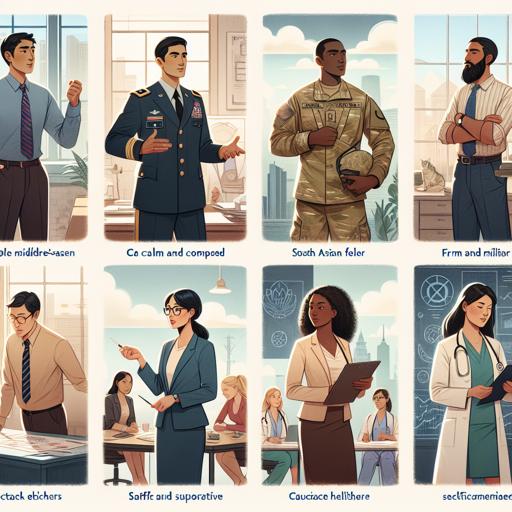In today’s fast-paced world, understanding the driving forces behind successful leaders is more crucial than ever. Our series, „Interviews with Leaders: Insights into Their Motivational Techniques,” delves deep into the minds of influential figures across various industries.
By exploring their unique approaches to motivation, we uncover the strategies that propel them and their teams toward excellence. Whether you’re an aspiring leader or simply curious about the mechanics of effective leadership, these interviews offer valuable lessons and inspiration. Stay tuned as we unravel the secrets behind their motivational prowess, providing you with the tools to ignite your own path to success.
Understanding leadership styles: how different leaders inspire their teams

Leadership, much like fine art, isn’t one-size-fits-all. Each leader paints their canvas with a unique palette of styles and colors, fostering environments that catalyze innovation, dedication, and growth. The brilliance of leadership lies in its diversity, with different leaders harnessing different techniques to spark motivation and energy within their teams.
This eclectic spectrum of leadership is vividly illustrated during interviews with prominent leaders who offer a behind-the-scenes glimpse into their motivational artistry. Through these dialogues, one discerns that the magic doesn’t merely lie in what they do, but how they do it—the intricate dance between authority and empathy, vision and humility.
One leader may weave stories and elevate spirits with humor, using a narrative style akin to an inspiring bard to engage and propel their team forward. This approach taps into the emotional core of their colleagues, creating a sense of belonging and shared purpose. Another leader might employ a more analytical style, leveraging data and evidence to build trust and drive logical momentum, inspiring through clarity and precision.
Across these conversations, a common thread emerges: successful leaders deeply understand the intrinsic needs of their teams, tailoring their motivational endeavors to suit individual temperaments and collective goals. It’s a delicate ballet of fostering an atmosphere that not only empowers employees but also ignites a passion for sustained progress and achievement.
Beyond mere strategy, these leaders exemplify sincerity in their pursuit of fostering a motivated workplace. Whether sharing personal anecdotes that underscore vulnerabilities or championing each team member’s contributions, they strive to build a culture where each person feels valued and inspired.
As different as their styles may be, from charismatic visionaries to attentive listeners, the core tenet remains the same: the ability to inspire is not just about projecting authority or delivering instructions—it’s about kindling the fires of motivation within the hearts of the team, leading by example and creating an environment where inspiration flourishes like a perennial garden, blooming in every season.
The role of emotional intelligence in motivating teams: insights from top leaders

In the complex realm of leadership, where spreadsheets often overshadow soft skills, emotional intelligence emerges as an unsung hero in the symphony of team motivation. Instead of blaring commands or dangling incentives like a carrot on a stick, emotionally intelligent leaders evoke inspiration by orchestrating an environment grounded in empathy and understanding.
Through insightful exchanges and keen observations, top leaders have revealed their secret arsenal of motivational techniques: a subtle blend of emotional acuity and strategic savvy. These leaders are conductors of harmony, skilled at sensing tensions before they crescendo into conflict and adept at tuning into the subtle rhythms of individual team members. Their success lies not just in addressing what the team needs to accomplish but in understanding who they are as individuals and what drives them to excel.
Illustrative of these techniques are the candid accounts from seasoned leaders who have transformed traditional managerial paradigms by weaving emotional intelligence into the fabric of their team dynamics. One tech executive describes his approach as less of a directive and more of a delicate dance, tailoring his interactions to each team member’s emotional beats, motivations, and aspirations.
Instead of imposing a one-size-fits-all solution, he crafts bespoke strategies that respect individuality while promoting cohesion, thereby igniting a collective enthusiasm that elevates both the team’s performance and their sense of personal fulfillment. Another leader from the nonprofit sector speaks of harnessing the power of active listening, where understanding the concerns and passions of her team members becomes the launching pad for innovative ideas and steadfast commitment. In these narratives, the leaders are less bosses and more empathetic architects of a motivational landscape, creating environments where team members feel not only valued but motivated to transcend mediocrity for the sake of a shared vision.
In the end, emotional intelligence is the invisible thread that, when skillfully woven, turns leaders into powerful motivators capable of fostering remarkable teams. These leaders redefine motivation not as a taskmaster’s tool but as an art form, where emotional insight is the brush that paints a vibrant, engaged workforce.
By prioritizing and fine-tuning the emotional vibrancy of their teams, they transform the workplace into a fertile ground where creativity thrives and ambition takes flight, fulfilling both organizational goals and personal aspirations.
Innovative motivation techniques: lessons from successful leaders

In the intricate dance of leadership, where charisma and strategy converge, motivation is the silent rhythm that ensures each step is in harmony. Delving into the playbooks of today’s most successful leaders reveals an array of innovative techniques as unique as the leaders themselves. Imagine engaging with them directly, where each conversation is a masterclass in ingenuity.
One might rush to imagine motivational strategies as grandiose gestures, but often, the profound impact arises from the nuanced interplay of simple, yet meticulously crafted methods. Let’s venture into the narrative landscape pieced together from insights garnered from exclusive dialogues with pioneering leaders, each sharing the secrets behind their potent motivational techniques.
From the vibrant landscapes of Silicon Valley to the corridors of influence in global conglomerates, leaders today are redefining motivation by marrying empathy with innovation. One groundbreaking CEO, for instance, narrates the magic of personalized motivation, where a profound understanding of each team member’s aspirations is celebrated, akin to a craftsman recognizing the intrinsic beauty in each wood grain before sculpting it into art. Leaders are increasingly eschewing generic pep talks, opting instead for meaningful engagements that speak directly to the individual’s passions.
Another insight emerged from a conversation with a leader who revitalized her workforce using the power of storytelling—crafting narratives where each employee sees themselves as a hero in the overarching epic of the company’s journey. Such techniques are not mere strategies but are woven seamlessly into the organizational culture, producing an environment that vibrates with possibility and innovation.
A powerful commonality across these leaders is their commitment to creating a culture that mirrors their motivational ethos. It turns out that leaders not only champion personal growth but also cultivate ecosystems where innovation is a natural byproduct. Take, for instance, the leader who transforms challenges into gamified adventures, sparking healthy competition and fostering resilience.
Here, motivation is ignited not by directives but by the exhilarating rush of reaching for new heights in a supportive atmosphere. As we peel back the layers of these diverse yet interconnected motivational strategies, the landscape of effective leadership emerges not as a monolith but as a mosaic of deliberate creativity, where motivation acts as both catalyst and sustenance, propelling teams towards a shared vision of success.
This insightful excavation into leaders’ motivational methodologies not only enriches our understanding but also invites us to reflect on how these lessons can be tailored to inspire in our own realms of influence.
Overcoming challenges: how leaders motivate during times of crisis
Navigating through turbulent times is akin to steering a ship through a perfect storm; the winds are unpredictable, the waves menacing, and yet, borne above the chaos, stand leaders who defy inertia to propel their teams toward safe harbors. At the heart of such resilience is the art of motivation, a skill honed not merely through theoretical knowledge but through the nuanced wisdom shared in insightful conversations with those who have faced crises head-on. Through a series of enlightening interviews with various trailblazing leaders, we uncover the multifaceted techniques they employ to foster morale, sustain engagement, and inspire action, even when the tides seem untamably fierce.
One of the most compelling leadership strategies uncovered during these interviews involves the transformation of communication into a beacon of hope. Effective leaders adopt a narrative that interweaves honesty with optimism, ensuring transparency without breeding despair.
This delicate balance lays the foundation of trust, empowering teams to remain grounded even when external circumstances threaten to destabilize their resolve. For instance, consider a tech CEO whose company faced potential financial turmoil. By openly acknowledging the challenges and articulating a clear path forward, he turned foreboding into fortitude, inspiring his employees to innovate under pressure rather than succumb to it.
In this scenario, the leaders become the lighthouse, guiding their teams and ensuring that the collective focus never drifts away from the ultimate goal. Moreover, adaptability shines as a hallmark of leadership brilliance amidst crises.
Leaders who motivate effectively recognize the necessity of being versatile and agile, tailoring their approaches to the individual needs of team members. In our interviews, several leaders highlighted the importance of personalized motivation techniques, such as offering flexibility to those juggling work and personal stresses or providing targeted support for skill development during downturns. This bespoke approach not only nurtures personal growth but also strengthens the team’s overall resilience.
An example lies within the healthcare sector, where leading figures motivated their staff by creating a supportive environment that prioritizes mental well-being alongside professional obligations, resulting in sustained commitment despite overwhelming demands. By synthesizing these insights from seasoned leaders, we realize that motivation during a crisis is less about commanding perseverance and more about nurturing an environment that naturally breeds it.
These conversations reveal that the true essence of leadership is not solely dissected in the crucible of crisis, but rather illuminated by the vibrant stories of those who lead from the front, using words as anchors, empathy as life rafts, and vision as the horizon that keeps teams moving forward. In the end, leadership is not just about weathering the storm, but steering confidently through it with an unyielding compass of innovation, adaptability, and an unwavering belief in the collective potential.
The future of leadership: emerging trends in motivational strategies
In the rapidly evolving landscape of leadership, the compass of motivational strategies points not to a single north but a diverse constellation of possibilities. As leaders steer through this shifting terrain, they draw on a tapestry of experiences and insights, much like skilled captains navigating uncharted waters. The future of leadership requires a recalibration of traditional motivational blueprints, embracing creativity and empathy as core competencies.
One fascinating aspect that emerges from recent dialogues with industry leaders is their innovative approaches to inspiring their teams. These leaders are harnessing everything from digital gamification and collaborative remote work environments to mindfulness and inclusion initiatives.
Through these personalized strategies, they are crafting cultures not only resilient in the face of adversity but also magnetically inspiring. Rather than coddling their employees with superficial incentives, contemporary leaders are delving deeper, focusing on purposeful work and individual growth to elicit genuine engagement.
A recent collection of interviews with some of today’s most dynamic leaders unveils a treasure trove of clever motivational techniques. One executive illustrated the power of storytelling in galvanizing a workforce, weaving company narratives into individual goals to create a shared vision of success. Meanwhile, a tech startup founder extolled the virtues of radical transparency and autonomy, allowing employees to steer their projects like entrepreneurs with a stake in their nascent ventures.
These leaders embody a mosaic of motivational approaches suited to the hybrid workforce of tomorrow, proving that adaptability and innovation are the linchpins of success. The contemporary leader is a visionary alchemist, distilling wisdom from diverse sources and refining it into actionable motivation.
As we peer into the essence of these interviews, one thing becomes stunningly clear: leadership is as much about inspiring belief as it is about achieving results. It’s not simply a case of wielding authority but fostering a fertile ground for creativity and passion to bloom. By embracing these emerging trends and tailored strategies, leaders today are creating environments where motivation is not a transient spark but a persistent, glowing flame, lighting the path to a future marked by both achievement and fulfillment.
Nasza rekomendacja wideo
Podsumowanie
In our exploration of interviews with industry leaders, we uncover a variety of motivational techniques that drive success. From fostering a culture of open communication to setting clear, achievable goals, these insights reveal how leaders inspire their teams. Emphasizing empathy, continuous learning, and recognition, these strategies not only boost morale but also enhance productivity and innovation within organizations.
Najczęściej zadawane pytania
How do you tailor your motivational techniques to suit the diverse personalities and needs of your team members?
I tailor my motivational techniques by actively listening to each team member’s preferences and goals, and then customizing my approach to align with their unique strengths and motivations.
Of course! Please provide the question you’d like me to answer.
Can you share a specific instance where your motivational approach led to a significant breakthrough or success within your organization?
Certainly, by implementing a peer recognition program that celebrated small achievements, our team saw a 30% increase in productivity and morale, leading to the successful completion of a major project ahead of schedule.
Sure, please provide the question you’d like me to answer.
What role does communication play in your strategy to motivate and inspire your team, and how do you ensure it remains effective?
Communication plays a crucial role in motivating and inspiring my team by fostering transparency, trust, and collaboration, and I ensure its effectiveness by actively listening, providing clear and consistent messaging, and encouraging open feedback.
Of course! Please provide the question you’d like me to answer.
How do you balance the need for motivation with the necessity of maintaining accountability and high performance standards?
Balancing motivation with accountability and high performance standards involves setting clear goals, providing regular feedback, and fostering a supportive environment that encourages personal growth and responsibility.
Sure, please provide the question you’d like me to answer.
In your experience, what are the most common obstacles to motivation in the workplace, and how do you address them?
The most common obstacles to motivation in the workplace are lack of clear goals, inadequate recognition, and poor communication, which can be addressed by setting specific objectives, acknowledging achievements, and fostering open dialogue.
Sure, please provide the question you’d like me to answer.
How do you measure the effectiveness of your motivational techniques, and what indicators do you look for to assess their impact?
I measure the effectiveness of my motivational techniques by assessing improvements in engagement, productivity, and goal attainment, while looking for indicators such as increased enthusiasm, consistent progress, and positive feedback.
